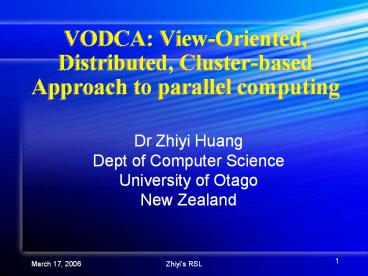VODCA:%20View-Oriented,%20Distributed,%20Cluster-based%20Approach%20to%20parallel%20computing - PowerPoint PPT Presentation
Title:
VODCA:%20View-Oriented,%20Distributed,%20Cluster-based%20Approach%20to%20parallel%20computing
Description:
VODCA is a system supporting View-Oriented Parallel ... A view-based debugger for VOPP. A fault-tolerant system for VODCA. March 17, 2006. Zhiyi's RSL ... – PowerPoint PPT presentation
Number of Views:36
Avg rating:3.0/5.0
Title: VODCA:%20View-Oriented,%20Distributed,%20Cluster-based%20Approach%20to%20parallel%20computing
1
VODCA View-Oriented, Distributed, Cluster-based
Approach to parallel computing
Dr Zhiyi Huang Dept of Computer
Science University of Otago New Zealand
2
Motivation
- DSM applications are not as efficient as MPI on
cluster computers
3
VOPP
- VODCA is a system supporting View-Oriented
Parallel Programming (VOPP) - Why a new programming style?
- Improve the performance of DSM applications on
cluster computers - Provide a programming style better than MPI
- Message passing is notoriously known as a
difficult programming style
4
What is a view?
- Suppose M is the set of data objects in shared
memory - A view is a group of data objects from the shared
memory - ? V, V?M
- Views must not overlap each other
- ? Vi, Vj, i ? j, Vi ? Vj ?
- Suppose there are n views in shared memory
- ? ViM
5
VOPP Requirements
- The programmer should divide the shared data into
a number of views according to the data flow of
the parallel algorithm. - A view should consist of data objects that are
always processed as an atomic set in a program. - Views can be created and destroyed anytime.
- Each view has a unique view identifier
6
VOPP Requirements (cont.)
- View primitives such as acquire_view and
release_view must be used when a view is
accessed. - acquire_view(View_A)
- A A 1
- release_view(View_A)
- acquire_Rview and release_Rview can be used when
a view is only read by a processor.
7
Example
- A VOPP program for a producer/consumer problem
If(prod_id 0) acquire_view(1)
produce(x) release_view(1) barrier(0) a
cquire_Rview(1) consume(x) release_Rview(1)
8
Advantages of VOPP
- Keep the convenience of shared memory programming
- Focus on data partitioning and data access
instead of data race and mutual exclusion - View primitives automatically achieve mutual
exclusion - View primitives are not extra burden
- The programmer can finely tune the parallel
algorithm by careful view partitioning
9
Philosophy of VOPP
- Shared memory is a critical resource that needs
to be used with care - If there is no need to use shared memory, dont
use it - Justification is wanted before a view is created
10
VOPP vs. MPI
- Easier for programmers than MPI
- For problems like task queue, programming with
MPI is horrific. - Can mimic any finely-tuned MPI program
- Shared message ? view
- Send/recv ? acquire_view
- Essential differences
- View is location transparent
- More barriers in VOPP
11
Implementation
- VODCA View-Oriented, Distributed, Cluster-based
Approach to parallel computing - VODCA version 1.0
- Released as an open source software
- A library run at the user space
- Based on View-based Consistency
- Use an efficient consistency protocol VOUPID
12
View-based Consistency
- Condition for View-based Consistency
- Before a processor Pi is allowed to access a view
by calling acquire_view or acquire_Rview, all
previous write accesses to data objects of the
view must be performed with respect to Pi
according to their causal order. - In VOPP, barriers are only used for
synchronization and have nothing to do with
consistency maintenance for DSM.
13
Consistency protocols
- They are page based
- Update protocol
- Modify immediately
- Invalidation protocol
- Use a write notice to invalidate a page
- When the page is accessed, a page fault causes
the fetch of diffs which are applied on the page
14
Consistency protocols (cont.)
- Home-based protocol
- Based on invalidate protocol, but
- For each page, use a copy as its home
- When a diff is created, it is applied to the home
copy immediately - When the page is accessed, a page fault causes
the fetch of the home copy (Pros resolve the
diff accumulation problem)
15
The VOUPID protocol
- View-Oriented Update Protocol with Integrated
Diff - Based on the update protocol
- Diffs of a page of a view are merged into a
single diff - The single diff is used to update the page when
the view is acquired
16
Experiment
- Use a cluster computer
- The cluster computer, in Tsinghua Univ., consists
of 128 Itanium 2 running Linux 2.4, connected by
InfiniBand. Each node has two 1.3 GHz processors
and 4 Gbytes RAM. We run two processes on each
node. - We used four applications, Integer Sort (IS),
Gauss, Successive Over-Relaxation (SOR), and
Neural Network (NN).
17
Related systems
- TreadMarks (TMK) is a state-of-the-art
Distributed Shared Memory system based on
traditional parallel programming. - Message Passing Interface (MPI) is a standard for
message passing-based parallel programming. We
used LAM/MPI.
18
Performance of NN
19
Performance of IS
20
Performance of SOR
21
Performance of Gauss
22
Future work on VOPP
- More benchmarks/applications
- Performance evaluation on larger clusters
- Optimized implementation of barriers for VOPP
- More auxiliary utilities for VOPP programmers
- A view-based debugger for VOPP
- A fault-tolerant system for VODCA
23
Questions?































